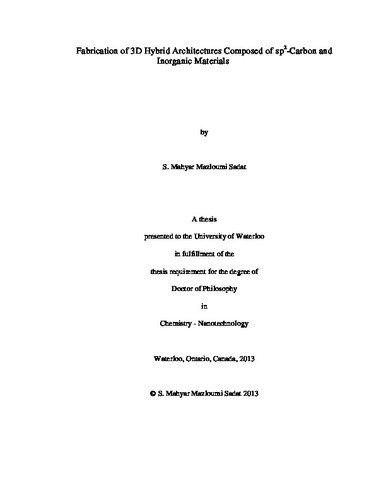| dc.description.abstract | Three dimensional (3D) hybrid architectures are new types of materials that have a number of technological applications. However, the synthesis of such materials has been problematic to date. The objective of this study is to fabricate 3D hybrid architectures composed of sp2-carbon nanomaterials and inorganic nanostructures using a convenient microwave assisted technique.
Sp2-Carbon nanomaterials such as carbon nanotubes (CNTs), graphene and its derivative graphene oxide (GO), have been explored by researchers as major components of hybrid materials due to their exceptional electrical, thermal, mechanical and biological properties. However, most of the research has been devoted to the hybrids with randomly dispersed phases. The present study explores the feasibility of using aligned 3D sp2-carbon structures in a bottom-up microwave-assisted chemical synthesis approach to fabricate various 3D sp2-carbon/inorganic hybrid architectures. The carbon nanostructures, either tubular or planar, not only contribute to the functionalities of the hybrids, but also template the ordered assembly of phases on nanometer scale.
Mimicking nature is a key to develop novel types of materials with enhanced physical and mechanical properties suitable for advanced applications (e.g. lightweight and yet tough materials that are extensively needed in automotive and aerospace industries). One approach to obtain such materials or devices is to mimic nature processes and synthesize hybrid materials with ordered structures on the nanometer scale. Those functional structures are fabricated in this thesis through an in-situ microwave synthesis of inorganic materials on 3D sp2-carbon architectures. Generally, in chapter 1, it was shown and discussed the procedures to fabricate 3D architectures of carbon nanotubes and graphene oxide as basic components for template synthesis of the hybrids. Then in chapter 2 the microwave chemical synthesis approach was introduced as a convenient route for fabricating inorganic materials such as zinc oxide (ZnO) which was shown to be used as UV sensors.
Through photolithography patterning of the iron catalyst thin films on Si/SiO2 substrates, 3D aligned CNT structures were fabricated and were coated in-situ with inorganic materials such as cobalt oxide, zinc oxide and manganese oxide using a microwave synthesis approach (chapter 3). The obtained aligned strips of CNT/Co3O4 were chosen as an example to illustrate the application of such 3D hybrids in energy storage applications. The capacitance of the aligned CNT/Co3O4 strips was measured to be 123.94 F/g.
Using graphene oxide as template for manufacturing the 3D sp2-carbon/inorganic hybrid structures, interesting novel layered configurations are obtained that are similar to the layered structures of exoskeleton of the mollusks nacre. The layered hybrid structure shown to be mechanically improved compared to its constituents (chapter 4). Finally in chapter 5, some of the future routes have been proposed for further research on this novel field of 3D hybrid materials composed of sp2-carbons and inorganic nanomaterials. | en |

